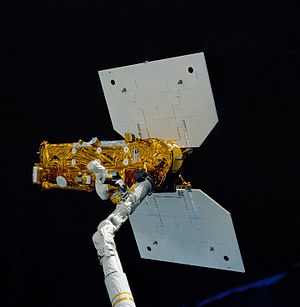
Back STS-41-G Arabic STS-41G Bulgarian STS-41-G Czech STS-41-G Danish STS-41-G German STS-41-G Spanish STS-41-G Estonian استیاس-۴۱-جی Persian STS-41-G Finnish STS-41-G French
 ERBS during deployment | |
| Names | Space Transportation System-13 |
|---|---|
| Mission type | Satellite deployment Radar imaging |
| Operator | NASA |
| COSPAR ID | 1984-108A |
| SATCAT no. | 15353 |
| Mission duration | 8 days, 5 hours, 23 minutes, 33 seconds (achieved) |
| Distance travelled | 5,293,847 km (3,289,444 mi) |
| Orbits completed | 133 |
| Spacecraft properties | |
| Spacecraft | Space Shuttle Challenger |
| Launch mass | 110,120 kg (242,770 lb) |
| Landing mass | 91,746 kg (202,265 lb) |
| Payload mass | 8,573 kg (18,900 lb) |
| Crew | |
| Crew size | 7 |
| Members | |
| EVAs | 1 |
| EVA duration | 3 hours, 29 minutes |
| Start of mission | |
| Launch date | October 5, 1984, 11:03:00 UTC |
| Rocket | Space Shuttle Challenger |
| Launch site | Kennedy Space Center, LC-39A |
| Contractor | Rockwell International |
| End of mission | |
| Landing date | October 13 1984, 16:26:33 UTC |
| Landing site | Kennedy Space Center, SLF Runway 33 |
| Orbital parameters | |
| Reference system | Geocentric orbit[1] |
| Regime | Low Earth orbit |
| Perigee altitude | 351 km (218 mi) |
| Apogee altitude | 391 km (243 mi) |
| Inclination | 57.00° |
| Period | 92.00 minutes |
| Instruments | |
| |
 STS-41-G mission patch  Top: Paul D. Scully-Power, Robert L. Crippen, Marc Garneau Bottom: Jon A. McBride, Sally K. Ride, Kathryn D. Sullivan, David C. Leestma. The replica of a gold astronaut pin near McBride signifies Unity. | |
STS-41-G (formerly STS-17) was the 13th flight of NASA's Space Shuttle program and the sixth flight of Space Shuttle Challenger. Challenger launched on October 5, 1984, and conducted the second shuttle landing at Kennedy Space Center on October 13, 1984. It was the first shuttle mission to carry a crew of seven, including the first crew with two women (Sally K. Ride and Kathryn D. Sullivan), the first American Extravehicular activity (EVA) involving a woman (Sullivan), the first Australian-born person to journey into space as well as the first astronaut with a beard[2][3] (Paul D. Scully-Power) and the first Canadian astronaut (Marc Garneau).
STS-41-G was the third shuttle mission to carry an IMAX camera on board to document the flight. Launch and in-orbit footage from the mission (including Sullivan and Leestma's EVA) appeared in the 1985 IMAX movie The Dream is Alive.
- ^ "Launch Log". Jonathan's Space Report. Retrieved January 15, 2022.
- ^ Rancourt, Linda (October 4, 1984). "Scully-Power shuttle flight counted down". The Day. pp. 1, 10.
- ^ Bilton, Ross (April 23, 2016). "Paul Scully-Power: the first Australian, and hipster, in space". The Australian.
© MMXXIII Rich X Search. We shall prevail. All rights reserved. Rich X Search